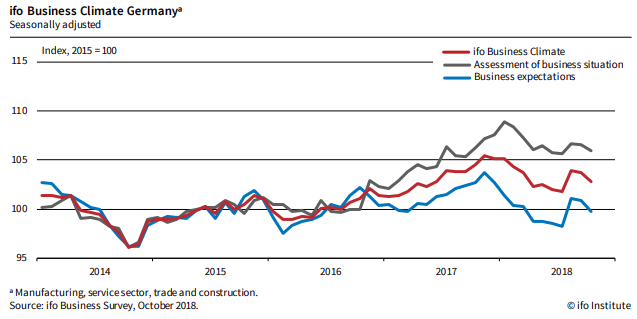Euro Shrugs Off Another Decline in German Business Sentiment ahead of October's European Central Bank Statement
- Written by: James Skinner
-

Commerzbank HQ looms over the Frankfurt skyline. Image © Andre Douque
- German Ifo index follows IHS Markit indices south.
- Business optimism declines amid litany of headwinds.
- But EUR resilient following earlier losses, ahead of ECB.
The Euro rose Thursday after shrugging off another fall German business optimism, although it had already come under pressure in recent days from signs the bloc's economic outlook is darkening.
Germany's Ifo Business Climate index, which measures optimism about the general business outlook across a group of some 7,000 German companies, reversed its summer gains and slipped lower for the month of October.
October's Ifo index came in at 102.8, down from 103.7 in September and beneath the consensus for a reading of around 103.1.
"Firms were less satisfied with their current business situation and less optimistic about the months ahead. Growing global uncertainty is increasingly taking its toll on the German economy. In manufacturing the index fell significantly due to markedly less optimistic business expectations," the Ifo Institute for Economic Research says.

Above: German Ifo index shown over four-year horizon.
New order growth continued to decline among German manufacturing companies in October and capacity utilisation fell by 0.5% to 87.1% as global demand for manufactured products slipped lower.
However, some of the downturn in sentiment was offset by a continued uptrend in activity within the construction sector, which saw confidence among German builders reach another record high.
"Stock markets, the Eurozone and the German economy, are all seeking guidance. In recent weeks, the stock market correction, the Italian fiscal conflict and a general cloud of negativism have all cast doubt about the future of the Eurozone growth cycle. At first glance, today’s Ifo drop seems to add to growing concerns," says Carsten Brzeski, an economist at ING Group.
Brzeski has told ING's clients Thursday's Ifo survey is reason to be cautious about the outlook for the economy but that it does not provide sufficient grounds for outright concern because the "current assessment" component of the survey still points to robust levels of growth at the start of the fourth quarter.
"The breakdown by sector confirms the message from other surveys and the hard data that the slowdown compared to last year’s strong pace of growth largely reflects developments in the manufacturing sector. This seems to be partly down to new auto emissions standards weighing on output, while firms reported that growing worries about the global economy were taking their toll," says Jessica Hinds, a European economist at Capital Economics.

Above: Euro-to-Dollar rate shown at hourly intervals.
The Euro-to-Dollar rate was quoted 0.10% higher at 1.1410 following the release on Thursday but has fallen 2.99% in the last month alone and is now down 4.9% for 2018, which is a deeper fall than that seen by the Pound. The Euro-to-Pound rate was down 0.06% at 0.8842 and has also fallen just 0.06% this year.

Above: Euro-to-Dollar rate shown at daily intervals.
Price action comes on a morning when the U.S. Dollar is trading on its back foot, down against much of the G10 basket, following rampant gains on Wednesday and ahead of October's European Central Bank (ECB) monetary policy update.
With the Euro already having suffered steep losses in the current week traders may be reluctant to offer it lower ahead of the ECB announcement in case the bank itself takes markets by surprise later on with another upbeat assessment of the bloc's interest rate prospects.
Thursday's Ifo survey follows hard on the heels of IHS Markit data covering sentiment and activity within both German and French manufacturing and services sectors.
Economists said at the time the data indicates the Eurozone economy grew at its slowest pace for nearly two and a half years at the beginning of the fourth quarter.
"The PMIs point to a significant slowdown in the Eurozone economy at the start of Q4, primarily due to weakness in Germany and broad-based sluggishness in manufacturing. We see little to cheer about in the headlines from Markit," says Claus Vistesen, chief Eurozone economist at Pantheon Macroeconomics. "To boot, executives’ outlook deteriorated sharply too."
Activity in Germany's mighty manufacturing sector grew at its slowest rate for almost three and a half years in October, while activity growth also weakened rapidly in the services sector. A similar pattern was observed in France.
The net effect of both sets of results was to push the Eurozone composite PMI, which measures activity and sentiment across all of the bloc's manufacturing and services industries, to a 25-month low of 52.7 for October.
"The PMI figure is compatible with a 0.3% Quarter-on-Quarter GDP growth, a deceleration from the pace seen in the first half of the year. Thanks to base effects average GDP for this year is still likely to come out at 2.0%, but the current growth pace means that next year’s GDP growth will fall back to something close to 1.5%," says Peter Houte, an economist at ING Group, in a note Wednesday.
Advertisement
Get up to 5% more foreign exchange by using a specialist provider to get closer to the real market rate and avoid the gaping spreads charged by your bank when providing currency. Learn more here




